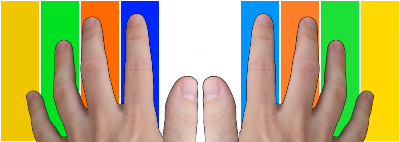The Symmetric Typing Project
More comfortable typing technique. Better keyboard layouts.
Symmetric Typing Project.
Promoting the use of a more symmetric system of typing on a traditional keyboard, and providing alternative keyboard layouts designed in accordance with this system.
For a standard Qwerty ANSI keyboard, our recommended system for touch-typing looks like this:
 The symmetric typing system. Pay special attention to the colors - keys of same color should be typed with the same finger.
The symmetric typing system. Pay special attention to the colors - keys of same color should be typed with the same finger.
Because of the staggered nature of the keyboard, perfect symmetry is not possible, but it is nevertheless a significant improvement over the traditional typing system, especially for the left hand. It is also similar to this recommendation. Note the B key is hard to reach, being equally distant between the two index fingers, so either hand can be used.
The traditional typing system is commonly taught, but we believe it to be unergonomic and poorly designed:
 The traditional typing system. Avoid!
The traditional typing system. Avoid!
The color-coding of keys on this site indicate which finger should be used:
 Type blue keys with your index fingers, orange with middle fingers, green with ring fingers, and yellow with pinkies.
Type blue keys with your index fingers, orange with middle fingers, green with ring fingers, and yellow with pinkies.
Rationale
In the traditional typing technique, the hands are supposed to compensate for the stagger of the keyboard, by moving up-and-to-the-left, or down-and-to-the-right. This project argues that this technique is uncomfortable, especially for the left hand, as the fingers have to move laterally with respect to the natural axis of the lower arm and wrist.
Try this simple experiment: put your hands in the home position, so that your left hand fingers are over A, S, D, F. Now try to type C. First with your middle finger, then with your index finger. It seems clear that the index finger more naturally moves down and inward to reach the C than the awkward wrist movement that is required for the middle finger. Despite being unorthodox, in practice many people use their index finger for C without even noticing, due to it being noticeably more comfortable. An equivalent argument can be made for the Z and X keys too.
It's well known that design of the standard keyboard dates back to mechanical typewriters, first invented in the 1870s. The keyboard stagger was necessary due the typewriter's internal mechanism of keys and levers. What is unfortunate is that no-one back then realized that life of the typist could be more comfortable if a little more attention had been paid to ergonomics. Even with those old typewriter designs, it would have been possible to have symmetric staggering, so that the left and right hand sides of the keyboard were mirror images - just like your hands.
 An example of what the keyboard might have look like if the staggering had been applied symmetrically.
An example of what the keyboard might have look like if the staggering had been applied symmetrically.
You might expect that with the dawning of the computer age, it would have been a perfect opportunity to reform keyboard design. But unfortunately that didn't happen, and the standard staggered design remains dominant. There are some interesting alternative keyboard designs out there (e.g. ErgoDox, Truly Ergonomic, TypeMatrix), but these tend to be obscure and hard to find for most consumers. In an ideal world there would be a readily available choice of both non-staggered or symmetrically-staggered keyboard designs available in the mainstream!
Fortunately, it is possible to mitigate many of the keyboard's design flaws - one the easiest and most beneficial of which is to adopt the more symmetric system promoted in these pages! It enables an almost-symmetric typing experience which feels more natural for those who make use of it.
To go to the next step and enjoy the full benefit the symmetric typing system in all its glory, you should consider learning one of our alternative keyboard layouts. Learning a new layout is not an easy process and will take many weeks - or even months - to type fluently. But think of it as a well-earned life skill - once you have adapted, many years of efficient, comfortable typing await!
Contents
– Alternative layoutsSoul Layout
Niro Layout
– Layouts comparison reults
License
The symmetric typing system is well known, and was not invented here. The purpose of this project is to publicize it and provide keyboard layouts specifically designed for it.
Information expressed in these pages is merely the opinion of the author. No warranty or guarantee is provided for the content on this site, including the layouts, downloads, or other information.